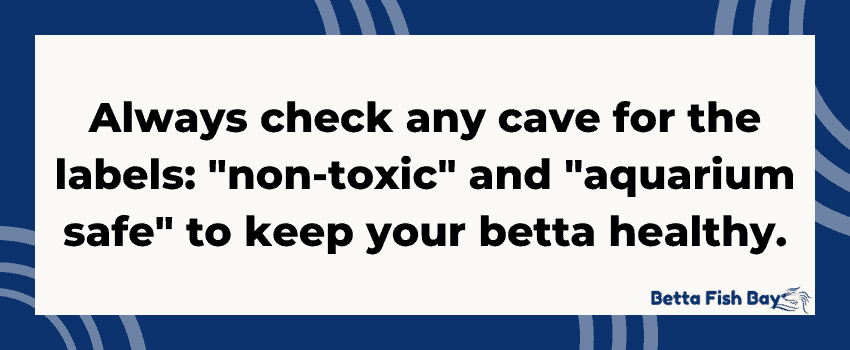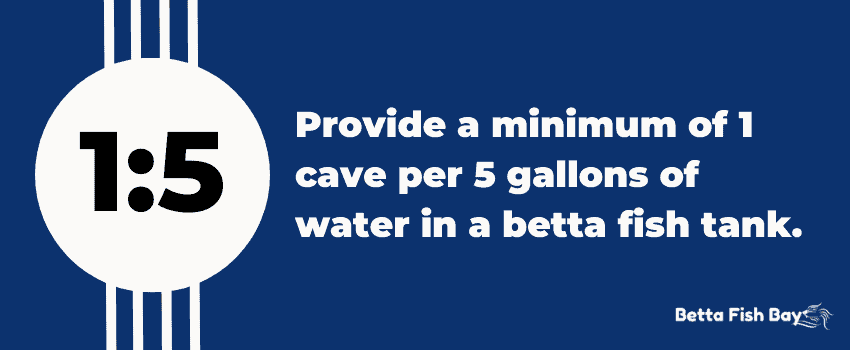Setting up your betta’s tank requires more effort than just getting the water parameters right.
Your pet needs an environment they feel safe in, which means picking the right tank decor.
Certain pieces of decor are considered must-haves, while others are more optional.
Betta fish benefit greatly from having a cave in their aquarium. The cave is a staple decoration for betta tanks because it allows them space to hide and rest. When you allow them to get somewhere dark, you ease stress in your betta. All around, the cave adds to their feelings of security and safety.

Table of Contents
Recreating the Natural Habitat of Betta Fish
When you set up your betta fish tank, you must do whatever possible to make them feel at home.
This means making the tank water and aquarium environment closely resemble their natural habitat.
We do this for two reasons:
- Their bodies are better suited to certain conditions.
- The familiarity relieves stress and fear, even in domestic betta fish.
Betta fish in the wild live in shallow, slow-moving, or still waters.
Examples include rice paddies, slow-moving streams, and freshwater marshes or ponds.
This is why we never create a strong filter current in their tank.
A strong current would harm your betta as they would struggle to swim against it.
In nature, betta fish see lots of plant life and find their own hiding places. In captivity, you have to provide those things for them.
This is why we offer them an abundance of plants and some aquatic caves.
Your betta doesn’t exactly remember what their natural habitat would look like. But they do share instincts with their predecessors.
When they’re scared or tired, they naturally seek shelter in those aquatic plants or caves.
The Role of Caves in a Betta Fish Tank
How Betta Fish Use Caves
So, what is your betta going to actually do with their cave?
It’s pretty simple. They retreat to their cave when they feel nervous and want to hide.
While betta fish are predatory, they are also prey to some larger fish.
It is completely natural for them to look for shelter when spooked or stressed.
But you may also see them spend time in a cave just resting. This is because it’s a nice, dark space without too much stimulation.
Even if your betta spends minimal time in their cave, they reap benefits from having one available.
For one thing, they know they have a place to go if they do feel threatened. This relieves stress and helps them feel safer moving about the tank.
It’s also a good place to settle down at night if they choose.
Even if you don’t often catch your betta hiding out there, they probably use the cave more than you think.
Types of Caves
There are essentially two types of caves for your betta: homemade/DIY and commercially produced caves.
The exact type you use depends on a lot of things.
Maybe you need to save money by fashioning your own homemade cave for your betta. Or you may struggle to find a product to accommodate your betta’s tail shape.
In the perfect environment, all betta fish need smooth edges.
But if your betta has an especially long flowing tail, they are more likely to be injured on sharp edges.
They may even snag on certain kinds of plants or decor without sharp edges.
This is where it’s helpful to create your own little house to stick in the aquarium.
If you opt to use a DIY cave, be sure to keep things natural. We recommend staying away from the paint.
But if you really want to go all out on making things cute, select an aquarium-safe paint.
These are usually hard to find because most craft paints boast being easy to clean up with water.
Here’s a popular, safe option on Amazon. The big drawback here is you won’t find a lot of fun colors.
Best Caves for Betta Fish

Commercial caves come in a few different materials, including:
- Ceramic
- Resin (plastic)
- Bamboo
- Coconut
- Wood
Each type of cave has its benefits and drawbacks, of course.
Bamboo, wood, and coconut caves are all natural and won’t leak chemicals into the water.
However, they must be sanded after you buy them to remove sharp edges.
Meanwhile, ceramic ones are more likely to be devoid of sharp edges. But they may come with paints you don’t want in the fish tank.
Plastic caves are durable. But you have to look carefully at the material they are made with.
Epoxy resin is an aquarium-safe plastic. But cheaper plastics are not safe to put in your betta’s home.
Our Favorites
The great thing about commercial caves is how much variety you’ll find.
A lot of them are designed to look like rocks or driftwood. This helps your betta’s aquarium mimic its natural habitat.
I love this hollow tree trunk on Amazon for a wooden cave. But you need sandpaper to smooth off any rough edges.
If you’d prefer to find something more quirky or cute, there are plenty of other caves you’ll like.
For example, here’s a resin Spongebob pineapple house we found on Amazon.
The important thing with this piece of decor is to smooth any rough edges. You want to make sure there is nothing your betta’s fins might snag on.
Alternatively, this ceramic stone decoration is already completely smooth.
This is also a nice, simple option, so it fits pretty well in just about any aquarium.
The big takeaway here is caves don’t have to stick out in the tank. There are loads of choices, and your betta benefits no matter what design you choose.
Drawbacks of Commercial Products
The problems you have with commercial betta caves vary from product to product.
Some common issues include:
- Sharp edges
- Unsafe materials
- Not sturdy/durable
Fortunately, these problems generally have simple solutions.
Fixing Sharp Edges
Most caves you buy on Amazon include a little note in the description reminding you to sand any rough edges.
Some items are not easy to smooth out, though.
Say you get a cave made of ceramic without paints. We expect it to be smooth and non-toxic based on this description.
But you still need to look it over and run your fingers across the surface to ensure it will be safe for your betta.
Ceramic caves are generally a lot harder to smooth out yourself. So rough edges are more of an issue here.
Take it up with the company you purchased from to hopefully get a refund.
Then consider getting a different material or style next time.
Some designs are more likely to have sharp points. But the hollow tree trunk or the stone is much easier to keep smooth.
Toxic and Unsafe Materials
Most of the time, unsafe materials come in plastic or paint.
When buying a resin (plastic) cave, read the description carefully. Ensure the product is labeled as non-toxic and aquarium-safe.
Anything in your fish tank must be made from waterproof epoxy resin.
Certain coatings, finishes, and plastics will likely tamper with the aquarium water quality.
Reading the description carefully is a quick way to save yourself the headache of chemicals dissolving in otherwise clean water.
As for paints, be very selective.
How Many Caves Should a Betta Fish Tank Have?

The number of caves you set up depends on two things:
- How many gallons is the tank?
- How many fish/creatures live there?
There’s a common misconception out there saying a betta fish thrives in a 2-3 gallon tank.
In reality, the ideal tank size is 5 gallons per betta.
We scale this up as other creatures (like snails and shrimp) move in because we want to accommodate their bio-load.
In a 5-gallon tank with just one betta fish, one or two caves is just fine!
For 10 gallons, you may want an extra cave. This is where we consider who lives in the tank.
Just one betta doesn’t need a ton of different caves to hide in, even in a larger space.
It may be better to focus on providing plants and other decor.
If you have snails and shrimp, they’ll all appreciate some hiding spots. This is where you add a couple more caves.
Remember not to overcrowd a tank with extra decor. As fun as it is to customize your betta’s tank, you must consider their comfort.
The purpose of getting a 5-gallon tank is to give them space to be active and explore.
Don’t compromise this with clutter.
Betta Love Their Hidey Holes!
Betta fish get a lot of benefits from having a cave in their tank.
It helps mimic their natural habitat and makes them feel safer from perceived danger.
Whatever your budget or taste looks like, you have many options. DIY caves work great; commercial caves come in all materials and shapes.
Here’s our step-by-step guide to setting up a betta tank if you’d like more tips!


